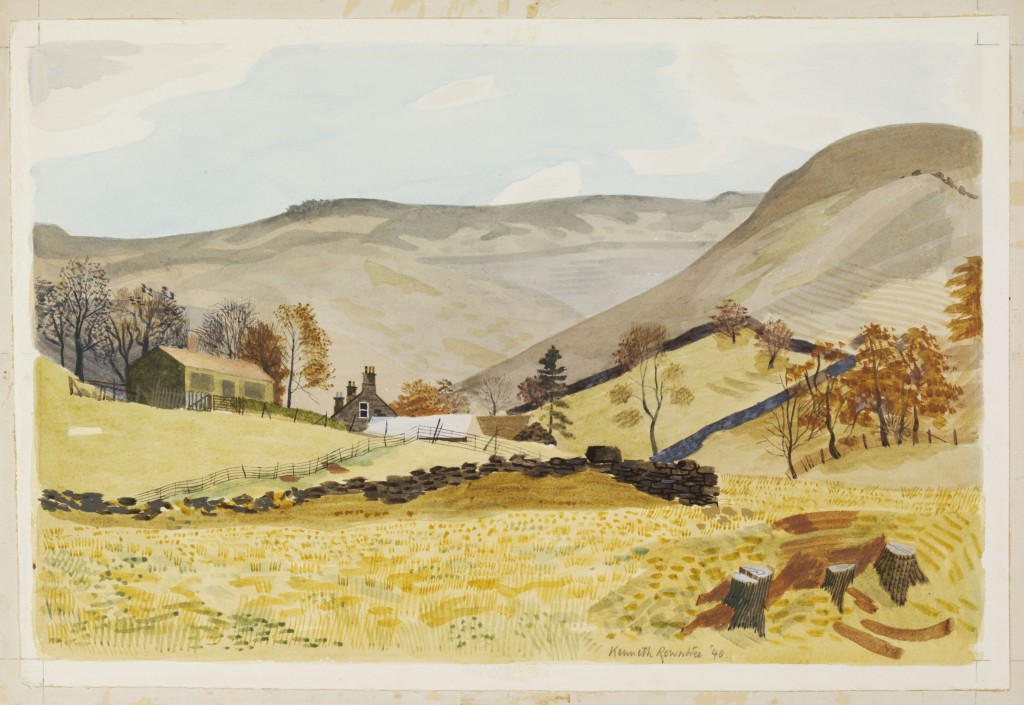Saturday 9 May-Sunday 9 August 2015
The Atkinson, Lord Street, Southport PR8 1DB T: 01704 533333 www.theatkinson.co.uk
A new exhibition explores images of lives and landscapes in Britain at the outbreak of World War II.
The Recording Britain collection, housed at London’s V&A, is the result of a unique and ambitious documentary project initiated by art historian and broadcaster Sir Kenneth Clark. The result was a collection of over 1,500 watercolours and drawings.
More than 90 artists – young and old, renowned professionals and gifted amateurs – were commissioned to make ‘sympathetic records’ of vulnerable buildings, landscapes and lifestyles at a time of great change.
The touring exhibition, Recording Britain, comes to Southport from Saturday 9 May. It is the first to showcase the significant artists of the World War II project, including Sir William Russel Flint, Charles Knight, Rowland Hilder, John Piper and Phyllis Dimond.
Photography and contemporary works from artists including Jeremy Deller and Tony Ray-Jones are included alongside the original Recording Britain works.
Jane Brown, museum and gallery office, The Atkinson said: “The Recording Britain collection was put together as the country faced not only the potentially devastating impact of bombardment and invasion, but also the more insidious but equally damaging effects of ‘progress’ and development.
“Both the original 1940s art works and the recent photographic additions provide a remarkable visual record of lives and landscapes under threat.”
Strong echos from the past can be felt from Kenneth Rowntree‘s The Smoke Room, Ashopton Inn. The 1940 watercolour depicts the interior of a pub, located in the former Derbyshire village of Ashopton, which was deliberately flooded a few years later to make way for the Ladybower Reservoir.
In total, Rowntree completed a group of 15 works recording land and houses marked for submersion in and around the villages of Ashopton and Derwent. His 1940 watercolour Grainfoot Farm recorded another area of Derwent Valley landscape submerged by the reservoir.
Bryon Dawson’s 1940 watercolour of Downham, near Clitheroe, depicts the beautifully preserved 18th and 19th century houses of a village that time forgot. To this day, this Ribble Valley treasure features no electricity lines, aerials or satellite dishes, making it a popular location for filming period dramas.
Other north west landscapes preserved by the Recording Britain project include a 1943 watercolour of the Manchester Ship Canal by prolific amateur Albert Pile and Blackburn artist and engraver Wilfred Fairclough’s 1940 drawing of The Old Bull and Darwen Street in his home town.
Fast forward to 1983 and photographer John Davies has captured the four imposing cooling towers of Salford’s Agecroft Power Station. Demolished just over ten years later, HM Prison Forest Bank has since been built on the site.
About Recording Britain
Recording Britain was the brainchild of Sir Kenneth Clark, who saw it as an extension of the Official War Artist scheme. By choosing watercolour painting as the medium of record, Clark hoped that the scheme would also help to preserve this characteristic English art form.
Recording Britain was intended to boost national morale by celebrating the country’s natural beauty and architectural heritage, but it was also a memorial to the war effort itself.
The earliest pictures show the landscapes of southern England which were under immediate threat from bomb damage and invasion; in due course the remit was expanded to include those landscapes, buildings and ways of life that were vulnerable to the destructive forces of ‘progress’ – urban expansion, housing developments, road-building and so on.
As well as many scenes of traditional country life, it also shows rural industries in decline – redundant tin mines in Cornwall, slate quarrying in Wales, dilapidated windmills. One contributor, Thomas Hennell, made a speciality of depicting country craftsmen and agricultural workers.
While some artists worked exclusively in their own localities – Charles Knight in Sussex for example – others travelled around the country to paint subjects selected by the Committee or suggested by local heritage groups.
Kenneth Rowntree, then living in Essex, made several watercolours of local churches, but also painted in Wales and his native Yorkshire. In Derbyshire he was asked to paint views in and around the village of Ashopton which was due to disappear under a reservoir built to supply the growing population of nearby Sheffield.
Hennell was sent at short notice to Hampshire to record the magnificent beech avenue at Lasham before it was felled to make way for an aerodrome.
The scheme employed several women, notably Barbara Jones and Enid Marx. Both were fascinated by English popular art – everything from fairgrounds and follies to topiary and inn signs – and both continued to record these ‘unsophisticated arts’ after the war.
Image is Kenneth Rowntree, Grainfoot Farm, Derwentdale, Derbyshire 1940, Watercolour, Given by the Pilgrim Trust, ©Victoria and Albert Museum, London.
-ENDS-
______________________________________________________________________
LISTING INFORMATION
Recording Britain: a touring V&A exhibition
Saturday 9 May-Sunday 9 August 2015
Posted on 1 May 2015 under General news







